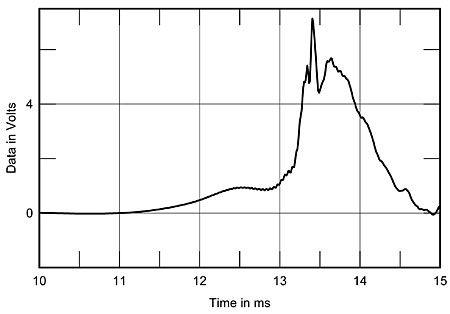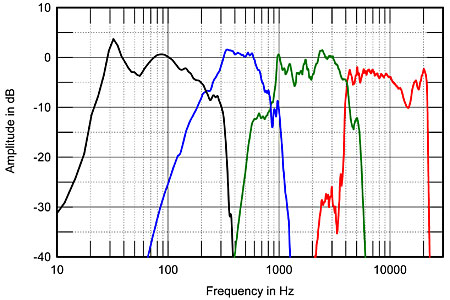| Columns Retired Columns & Blogs |
Cabasse La Sphère powered loudspeaker Measurements
Sidebar 3: Measurements
Footnote 1: Its 28" diameter will not fit through the door to my test lab, for example.
The Cabasse La Sphère is bulky enough (footnote 1), heavy enough, and, with its need for quad-amplification, complicated enough that I felt that, rather than have the loudspeaker shipped to my lab for measurement, I would travel to it. So I paid a visit to Mikey's listening room to take the measurements, which also allowed me to give it a listen. I was very impressed by the speaker when I auditioned it at the 2007 Consumer Electronics Show, thinking it had a delicacy that belied its bulk, and I heard much of what Mikey described in his auditioning comments.
Rather than my usual speaker-measuring setup, DRA Labs' MLSSA, which is tied to a desktop PC, I used SMUG Software's Fuzzmeasure program running on my Mac laptop, in conjunction with an EarthWorks omni mike and a Metric Halo ULN-2 FireWire sound processor. Like MLSSA, Fuzzmeasure allows the user to "gate" a loudspeaker's measured impulse response to produce, using FFT analysis, an anechoic response; but rather than MLSSA's MLS signal, Fuzzmeasure uses a "chirp" signal. I have previously compared both measuring systems; with gate and FFT parameters set identically, and with the microphone at precisely the same point in space in front of a loudspeaker, they produce identical measured responses, as you might expect.
As I understand the Sphère is fundamentally an active system, it wasn't appropriate to measure voltage sensitivity or impedance. Therefore, the first measurement I discuss here is the speaker's impulse response, taken on the tweeter axis at 1m. (Because I measured the speaker in MF's listening room, with room furnishings and boundaries present, I had to get closer to the speaker than is optimal for the measurements.) Fuzzmeasure has an operational mode that allows the user to compensate for the time it takes the DAC feeding the amplifier with the test signal and the ADC operating on the measurement-mike signal to perform their conversions. Even so, if you look at the horizontal scale of the measured impulse response (fig.1), you can see that the impulse arrives at the microphone between 13 and 14 milliseconds after leaving the loudspeaker. Because sound travels about 13" in 1ms, this result implies that the microphone was more than four times farther away from the loudspeaker than 1m.

Fig.1 Cabasse La Sphère, impulse response on tweeter axis at 1m (5ms time window, 30kHz bandwidth).
The difference arises from the fact that the Sphère has a digital crossover, with its own A/D and D/A converters. The extra 10ms is the crossover's "latency"—ie, the time it takes to process the signal—and is equivalent to moving the speakers back by 9' or so. This time delay is small enough not to be an issue if the Sphère is used to play back video soundtracks.
Fig.2 shows the Sphère's step response, calculated from the impulse-response data. Though there is a sharp rise just after the 13ms mark, some lower-frequency energy arrives before that time, and the shape only roughly resembles the right triangle that would indicate a time-coincident design. I therefore examined the step responses of the individual drive-units, again on the tweeter axis at 1m. These are shown in fig.3. The black trace is the woofer's output: positive-going, it starts to slowly rise above the time axis just before the 11ms mark. (The crossover's low-pass filter necessarily slows its risetime—talk of "fast" woofers (footnote 2) always ignores this fact.) The low-midrange unit's step is the blue trace; the upper-midrange unit's is the green trace. The steps of both are initially negative-going, but the bulk of the energy is on the positive side of the time axis and arrives at approximately the same time as that of the woofer's maximum.

Fig.2 Cabasse La Sphère, step response on tweeter axis at 1m (5ms time window, 30kHz bandwidth).

Fig.3 Cabasse La Sphère, step responses of: tweeter (red), upper-midrange unit (green), low-midrange unit (blue), and woofer (black), all on tweeter axis at 1m (5ms time window, 30kHz bandwidth).
The tweeter's step is the red trace—the pre-ringing is presumably the residual effect of the Finite Impulse Response (FIR) high-pass filter, and the positive peak arrives just a little too late to sharpen the speaker's overall step. While this may well not matter subjectively, evident in the decay of the tweeter's and the midrange unit's step responses is some ringing that might well do so. (Both the filter's pre-ringing and the tweeter's post-impulse ringing can also be seen in the impulse response, fig.1.)
Turning to the frequency domain, fig.4 shows the individual drive-unit outputs, again measured on the tweeter axis at 1m. Again, the woofer's output is shown in black, the low-midrange unit's in blue, the midrange unit's in green, and the tweeter's in red. The outputs of the low-midrange unit below 500Hz and the woofer below 300Hz were taken in the nearfield. The relative levels of the four units were as set by designer Christophe Cabasse when he set up the speakers in MF's room. The tweeter appears to have been set around 3dB too low in level—I am sure this contributed to MF's finding the sound a little dark—and the steep rolloff above 22kHz is due to the fact that the digital crossover's A/D converter operates at 48kHz. I suspect that the designer felt that higher conversion precision could be obtained by running the converter at 48kHz rather than at, say, 96kHz.

Fig.4 Cabasse La Sphère, quasi-anechoic responses on tweeter axis at 1m of: tweeter (red), upper-midrange unit (green), low-midrange unit (blue), woofer (black).
The crossover's digital-filter slopes can be seen to be very steep, with very little overlap of the three upper-frequency drive-unit outputs. The low-midrange unit hands over to the upper-midrange unit between 800 and 900Hz, while the tweeter takes over above 4kHz. However, the crossover from the low-midrange unit to the woofer appears to feature asymmetrical acoustic slopes and a degree of overlap. As set, the woofer's output peaks at 32Hz before starting a steep rolloff with a third-order slope, rather than the expected second-order slope from the sealed-box tuning. The upper-frequency drive-units are generally well behaved in their passbands. I did initially suspect that the peaks and dips in the upper-midrange unit's response were due to room reflections, but they are actually due to diffraction from the openings for the 22" woofer.
I haven't shown the Sphère's overall response at 1m, but I have shown the spatially averaged response (fig.5). To produce this graph, I averaged 40 measurements taken for each speaker individually in a rectangular grid centered on the position of Mikey's ears in his listening seat. The spatial averaging reduces the effect of room resonances; I have found that this technique's integration of the on-axis response with the room's reverberant field—which is strongly influenced by the speaker's power response—gives a good correlation between the shape of the graph and the perceived balance. The large peak at 32Hz stems both from the woofer's intrinsic response and from the close-to-the-corner room placement, the latter maximally exciting what I assume is the lowest-frequency diagonal room mode. The Sphère's low bass did sound heavy and powerful when I listened to the speakers. Higher in frequency, the middle of the midrange is a little hot and the tweeter is slightly shelved down. But other than those characteristics, the Cabasse speaker's room response is generally smooth.

Fig.5 Cabasse La Sphère, spatially averaged, 1/6-octave response in MF's listening room.
Without my being able to measure the Cabasse La Sphère in my lab, its measured performance in Mikey's room unfortunately leaves some questions unanswered. But overall, it seems a well-engineered design. I'm not surprised Mikey liked it as much as he did.—John Atkinson
Footnote 1: Its 28" diameter will not fit through the door to my test lab, for example.
Footnote 2: Audiophiles are actually talking about the Q of the woofer tuning when they use this terminology. A "fast" woofer has the same slow risetime as a "slow" woofer, but doesn't ring as long following a transient.
- Log in or register to post comments




































